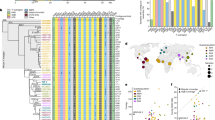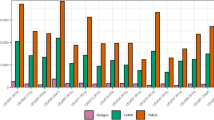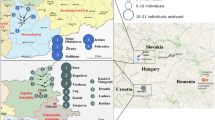Abstract
Mendez and colleagues reported the identification of a Y chromosome haplotype (the A00 lineage) that lies at the basal position of the Y chromosome phylogenetic tree. Incorporating this haplotype, the authors estimated the time to the most recent common ancestor (TMRCA) for the Y tree to be 338 000 years ago (95% CI=237 000–581 000). Such an extraordinarily early estimate contradicts all previous estimates in the literature and is over a 100 000 years older than the earliest fossils of anatomically modern humans. This estimate raises two astonishing possibilities, either the novel Y chromosome was inherited after ancestral humans interbred with another species, or anatomically modern Homo sapiens emerged earlier than previously estimated and quickly became subdivided into genetically differentiated subpopulations. We demonstrate that the TMRCA estimate was reached through inadequate statistical and analytical methods, each of which contributed to its inflation. We show that the authors ignored previously inferred Y-specific rates of substitution, incorrectly derived the Y-specific substitution rate from autosomal mutation rates, and compared unequal lengths of the novel Y chromosome with the previously recognized basal lineage. Our analysis indicates that the A00 lineage was derived from all the other lineages 208 300 (95% CI=163 900–260 200) years ago.
Similar content being viewed by others
Log in or create a free account to read this content
Gain free access to this article, as well as selected content from this journal and more on nature.com
or
References
FamilyTreeDNA: Y-Haplogroup A Project - Y-DNA Classic Charthttp://www.familytreedna.com/public/Haplogroup_A/default.aspx?section=yresults Vol 2013.
Mendez FL, Krahn T, Schrack B et al: An african american paternal lineage adds an extremely ancient root to the human y chromosome phylogenetic tree. Am J Hum Genet 2013; 92: 454–459.
Cruciani F, Trombetta B, Massaia A, Destro-Bisol G, Sellitto D, Scozzari R : A revised root for the human Y chromosomal phylogenetic tree: the origin of patrilineal diversity in Africa. Am J Hum Genet 2011; 88: 814–818.
Thomson R, Pritchard JK, Shen P, Oefner PJ, Feldman MW : Recent common ancestry of human Y chromosomes: evidence from DNA sequence data. Proc Natl Acad Sci USA 2000; 97: 7360–7365.
Wilder JA, Mobasher Z, Hammer MF : Genetic evidence for unequal effective population sizes of human females and males. Mol Biol Evol 2004; 21: 2047–2057.
Tang H, Siegmund DO, Shen P, Oefner PJ, Feldman MW : Frequentist estimation of coalescence times from nucleotide sequence data using a tree-based partition. Genetics 2002; 161: 447–459.
Poznik GD, Henn BM, Yee MC et al: Sequencing Y chromosomes resolves discrepancy in time to common ancestor of males versus females. Science 2013; 341: 562–565.
Klyosov AA, Rozhanskii IL : Re-examining the ‘out of africa’ theory and the origin of Europeoids (Caucasoids) in light of DNA genealogy. Adv Anthropol 2012; 2: 80–86.
McDougall I, Brown FH, Fleagle JG : Stratigraphic placement and age of modern humans from Kibish, Ethiopia. Nature 2005; 433: 733–736.
Hammer MF : Human hybrids. Sci Am 2013; 308: 66–71.
Yang MA, Malaspinas AS, Durand EY, Slatkin M : Ancient structure in Africa unlikely to explain Neanderthal and non-African genetic similarity. Mol Biol Evol 2012; 29: 2987–2995.
Green RE, Krause J, Briggs AW et al: A draft sequence of the Neanderthal genome. Science 2010; 328: 710–722.
Xue Y, Wang Q, Long Q et al: Human Y chromosome base-substitution mutation rate measured by direct sequencing in a deep-rooting pedigree. Curr Biol 2009; 19: 1453–1457.
Francalacci P, Morelli L, Angius A et al: Low-pass DNA sequencing of 1200 Sardinians reconstructs European Y-chromosome phylogeny. Science 2013; 341: 565–569.
Kong A, Frigge ML, Masson G et al: Rate of de novo mutations and the importance of father's age to disease risk. Nature 2012; 488: 471–475.
Kuroki Y, Toyoda A, Noguchi H et al: Comparative analysis of chimpanzee and human Y chromosomes unveils complex evolutionary pathway. Nat Genet 2006; 38: 158–167.
Skaletsky H, Kuroda-Kawaguchi T, Minx PJ et al: The male-specific region of the human Y chromosome is a mosaic of discrete sequence classes. Nature 2003; 423: 825–837.
Wei W, Ayub Q, Chen Y et al: A calibrated human Y-chromosomal phylogeny based on resequencing. Genome Res 2013; 23: 388–395.
Pink CJ, Swaminathan SK, Dunham I, Rogers J, Ward A, Hurst LD : Evidence that replication-associated mutation alone does not explain between-chromosome differences in substitution rates. Genome Biol Evol 2009; 1: 13–22.
Wilson Sayres MA, Venditti C, Pagel M, Makova KD : Do variations in substitution rates and male mutation bias correlate with life-history traits? A study of 32 mammalian genomes. Evolution 2011; 65: 2800–2815.
Taylor J, Tyekucheva S, Zody M, Chiaromonte F, Makova KD : Strong and weak male mutation bias at different sites in the primate genomes: insights from the human-chimpanzee comparison. Mol Biol Evol 2006; 23: 565–573.
Charlesworth B : The role of background selection in shaping patterns of molecular evolution and variation: evidence from variability on the Drosophila X chromosome. Genetics 2012; 191: 233–246.
Charlesworth B, Charlesworth D : The degeneration of Y chromosomes. Philos Trans R Soc Lond B Biol Sci 2000; 355: 1563–1572.
Wilson MA, Makova KD : Evolution and survival on eutherian sex chromosomes. PLoS Genet 2009; 5: e1000568.
Repping S, Skaletsky H, Brown L et al: Polymorphism for a 1.6-Mb deletion of the human Y chromosome persists through balance between recurrent mutation and haploid selection. Nat Genet 2003; 35: 247–251.
Graves JA : Sex chromosome specialization and degeneration in mammals. Cell 2006; 124: 901–914.
Repping S, van Daalen SK, Korver CM et al: A family of human Y chromosomes has dispersed throughout northern Eurasia despite a 1.8-Mb deletion in the azoospermia factor c region. Genomics 2004; 83: 1046–1052.
Wilson Sayres MA, Lohmueller KE, Nielsen R Natural selection reduced diversity on human Y chromosomes. arXiv preprint:13035012 2013.
King TE, Jobling MA : Founders, drift, and infidelity: the relationship between Y chromosome diversity and patrilineal surnames. Mol Biol Evol 2009; 26: 1093–1102.
Jobling MA : The impact of recent events on human genetic diversity. Philos Trans R Soc Lond B Biol Sci 2012; 367: 793–799.
Chiaroni J, Underhill PA, Cavalli-Sforza LL : Y chromosome diversity, human expansion, drift, and cultural evolution. Proc Natl Acad Sci USA 2009; 106: 20174–20179.
Scally A, Durbin R : Revising the human mutation rate: implications for understanding human evolution. Nat Rev Genet 2012; 13: 745–753.
Miyata T, Hayashida H, Kuma K, Mitsuyasu K, Yasunaga T : Male-driven molecular evolution: a model and nucleotide sequence analysis. Cold Spring Harb Symp Quant Biol 1987; 52: 863–867.
Wyrobek AJ, Eskenazi B, Young S et al: Advancing age has differential effects on DNA damage, chromatin integrity, gene mutations, and aneuploidies in sperm. Proc Natl Acad Sci USA 2006; 103: 9601–9606.
Organisation for Economic Co-operation and Development (OECD). Social Policy Division: SF2.3: Mean age of mothers at first childbirth 2012.
CDC, http://www.cdc.gov/nchs/fastats/births.htm, 2010.
Herlihy D : Medieval Households. Harvard University Press, 1985, pp 104–107.
Parkin TG : Old Age in the Roman World: A Cultural and Social History. JHU Press, 2003, pp 195–196.
Population Division of the Department of Economic and Social Affairs of the United Nations Secretariat: World Population Prospects: The 2012 Revision 2012.
Mendez FL, Watkins JC, Hammer MF : Global genetic variation at OAS1 provides evidence of archaic admixture in Melanesian populations. Mol Biol Evol 2012; 29: 1513–1520.
Mounier Al Marchal Fo, Condemi S : Is Homo heidelbergensis a distinct species? New insight on the Mauer mandible. J Hum Evol 2009; 56: 219–246.
Schwartz JH, Tattersall I : Significance of some previously unrecognized apomorphies in the nasal region of Homo neanderthalensis. Proc Natl Acad Sci USA 1996; 93: 10852–10854.
Bischoff JL, Williams RW, Rosenbauer RJ et al: High-resolution U-series dates from the Sima de los Huesos hominids yields: implications for the evolution of the early Neanderthal lineage. J Archaeol Sci 2007; 34: 763–770.
Finlayson C, Pacheco FG, Rodríguez-Vidal J et al: Late survival of Neanderthals at the southernmost extreme of Europe. Nature 2006; 443: 850–853.
White TD, Asfaw B, DeGusta D et al: Pleistocene Homo sapiens from Middle Awash, Ethiopia. Nature 2003; 423: 742–747.
Clark JD, Beyene Y, WoldeGabriel G et al: Stratigraphic, chronological and behavioural contexts of Pleistocene Homo sapiens from Middle Awash, Ethiopia. Nature 2003; 423: 747–752.
Cann RL, Stoneking M, Wilson AC : Mitochondrial DNA and human evolution. Nature 1987; 325: 31–36.
Dawkins R : The Ancestor's Tale, A Pilgrimage to the Dawn of Evolution. Houghton Mifflin Company: Boston, 2004.
Lachance J, Vernot B, Elbers Clara C et al: Evolutionary history and adaptation from high-coverage whole-genome sequences of diverse African hunter-gatherers. Cell 2012; 150: 457–469.
Yu N, Fu Y-X, Li W-H : DNA polymorphism in a worldwide sample of human X chromosomes. Mol Biol Evol 2002; 19: 2131–2141.
Kaessmann H, Heißig F, Von Haeseler A, Pääbo S : DNA sequence variation in a non-coding region of low recombination on the human X chromosome. Nat Genet 1999; 22: 78–81.
Schuster SC, Miller W, Ratan A et al: Complete Khoisan and Bantu genomes from southern Africa. Nature 2010; 463: 943–947.
Behar DM, van Oven M, Rosset S et al: A ‘Copernican’ reassessment of the human mitochondrial DNA tree from its root. Am J Hum Genet 2012; 90: 675–684.
Acknowledgements
TT was supported by NIH-NICHD: HD070996 and NIH-NIGMS GM068968 grants. We would like to thank Thomas Krahn and Melissa A Wilson Sayres for commenting on this manuscript. We are grateful to two anonymous reviewers who helped us improve the manuscript.
Author information
Authors and Affiliations
Corresponding author
Ethics declarations
Competing interests
The authors declare no conflict of interest.
Additional information
Supplementary Information accompanies this paper on European Journal of Human Genetics website
Supplementary information
Rights and permissions
About this article
Cite this article
Elhaik, E., Tatarinova, T., Klyosov, A. et al. The ‘extremely ancient’ chromosome that isn’t: a forensic bioinformatic investigation of Albert Perry’s X-degenerate portion of the Y chromosome. Eur J Hum Genet 22, 1111–1116 (2014). https://doi.org/10.1038/ejhg.2013.303
Received:
Revised:
Accepted:
Published:
Issue date:
DOI: https://doi.org/10.1038/ejhg.2013.303
Keywords
This article is cited by
-
Between Lake Baikal and the Baltic Sea: genomic history of the gateway to Europe
BMC Genetics (2017)
-
Differential Evolution approach to detect recent admixture
BMC Genomics (2015)
-
Reply to Mendez et al: the ‘extremely ancient’ chromosome that still isn’t
European Journal of Human Genetics (2015)
-
Reply to ‘The ‘extremely ancient’ chromosome that isn’t’ by Elhaik et al
European Journal of Human Genetics (2015)
-
The Y-chromosome point mutation rate in humans
Nature Genetics (2015)



